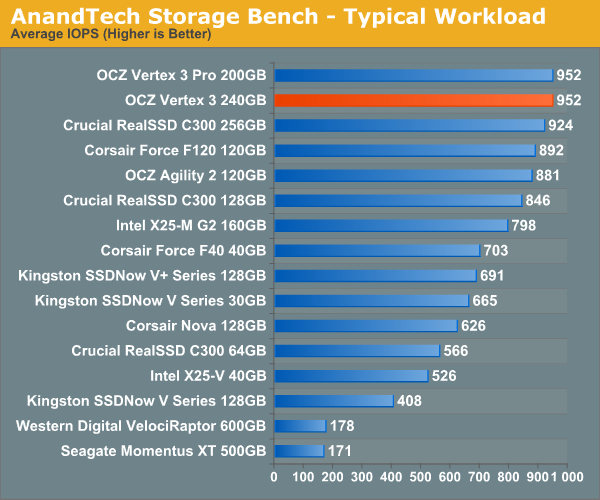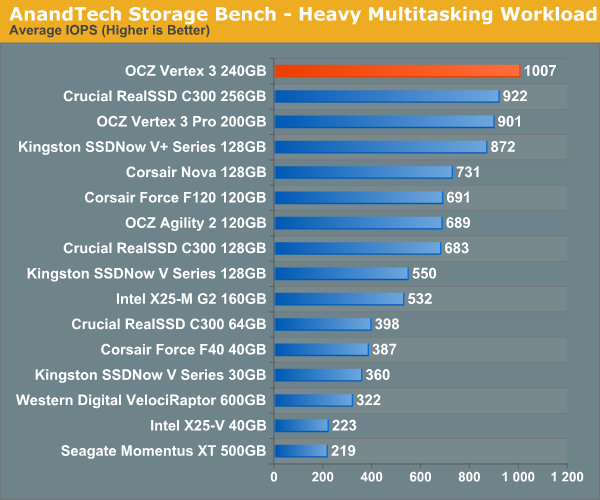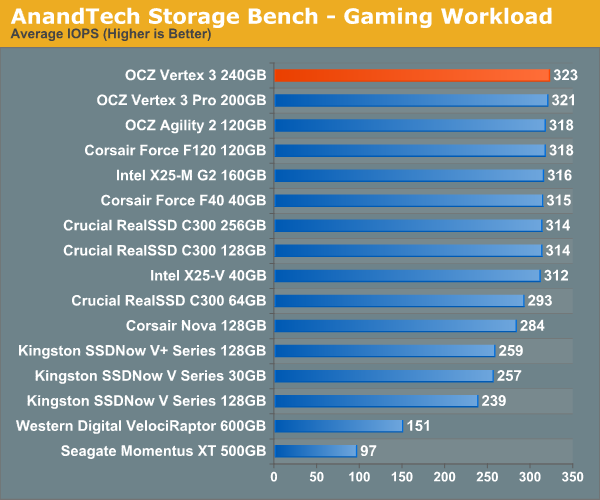OCZ Vertex 3 Preview: Faster and Cheaper than the Vertex 3 Pro
by Anand Lal Shimpi on February 24, 2011 9:02 AM ESTAnandTech Storage Bench 2010
To keep things consistent we've also included our older Storage Bench. Note that the old storage test system doesn't have a SATA 6Gbps controller, so we only have one result for the 6Gbps drives.
The first in our benchmark suite is a light/typical usage case. The Windows 7 system is loaded with Firefox, Office 2007 and Adobe Reader among other applications. With Firefox we browse web pages like Facebook, AnandTech, Digg and other sites. Outlook is also running and we use it to check emails, create and send a message with a PDF attachment. Adobe Reader is used to view some PDFs. Excel 2007 is used to create a spreadsheet, graphs and save the document. The same goes for Word 2007. We open and step through a presentation in PowerPoint 2007 received as an email attachment before saving it to the desktop. Finally we watch a bit of a Firefly episode in Windows Media Player 11.
There’s some level of multitasking going on here but it’s not unreasonable by any means. Generally the application tasks proceed linearly, with the exception of things like web browsing which may happen in between one of the other tasks.
The recording is played back on all of our drives here today. Remember that we’re isolating disk performance, all we’re doing is playing back every single disk access that happened in that ~5 minute period of usage. The light workload is composed of 37,501 reads and 20,268 writes. Over 30% of the IOs are 4KB, 11% are 16KB, 22% are 32KB and approximately 13% are 64KB in size. Less than 30% of the operations are absolutely sequential in nature. Average queue depth is 6.09 IOs.
The performance results are reported in average I/O Operations per Second (IOPS):

If there’s a light usage case there’s bound to be a heavy one. In this test we have Microsoft Security Essentials running in the background with real time virus scanning enabled. We also perform a quick scan in the middle of the test. Firefox, Outlook, Excel, Word and Powerpoint are all used the same as they were in the light test. We add Photoshop CS4 to the mix, opening a bunch of 12MP images, editing them, then saving them as highly compressed JPGs for web publishing. Windows 7’s picture viewer is used to view a bunch of pictures on the hard drive. We use 7-zip to create and extract .7z archives. Downloading is also prominently featured in our heavy test; we download large files from the Internet during portions of the benchmark, as well as use uTorrent to grab a couple of torrents. Some of the applications in use are installed during the benchmark, Windows updates are also installed. Towards the end of the test we launch World of Warcraft, play for a few minutes, then delete the folder. This test also takes into account all of the disk accesses that happen while the OS is booting.
The benchmark is 22 minutes long and it consists of 128,895 read operations and 72,411 write operations. Roughly 44% of all IOs were sequential. Approximately 30% of all accesses were 4KB in size, 12% were 16KB in size, 14% were 32KB and 20% were 64KB. Average queue depth was 3.59.

The gaming workload is made up of 75,206 read operations and only 4,592 write operations. Only 20% of the accesses are 4KB in size, nearly 40% are 64KB and 20% are 32KB. A whopping 69% of the IOs are sequential, meaning this is predominantly a sequential read benchmark. The average queue depth is 7.76 IOs.











85 Comments
View All Comments
Figaro56 - Tuesday, March 1, 2011 - link
Excuse me, but I'm confused. Why would a person rather get a refurb? For the warranty?What do you think a refurb part is any way? It's someone's used part that is not only used, but it also had a mfg defect. Are you kidding me?!
Figaro56 - Tuesday, March 1, 2011 - link
If you think a refurb in some way has more value go for it. I have never had a problem buying used from someone, just stay away from bad used parts venues like Ebay or Craigslist.Figaro56 - Tuesday, March 1, 2011 - link
I got my C300 256GB as an early adopter when they finally fixed their infamous firmware issue. That's cost you pay for being an "early adopter enthusiast."zebrax2 - Thursday, February 24, 2011 - link
Games i believe are sequential in naturesticks435 - Thursday, February 24, 2011 - link
This is correct. They are sequential reads. I really wish they Anand would have shown the PC Vantage gaming scores. Hopefully the full review will them them, along with the test bench 2010 on the Sandy bridge platform, since the new bench is only 2 workloads and gaming is a very specific type of workload.B3an - Friday, February 25, 2011 - link
I'd also like to see more real world and basic tests. Normal everyday things. As mentioned, Win7 start times, Photoshop tests, game loading times and so on...Figaro56 - Friday, February 25, 2011 - link
I own a Crucial RealSSD C300 256GB myself. After reading this review I have come to the same conclusion. Yes there is a margin of performance improvement with the Vertex 3, but not so great as to make you crazy enough to sell your C300 for $100 and jump on the OCZ Vertex 3 test group. I would wait awhile to see how this Vertex 3 with it's questionable new 25nm NAND holds up in the real world. I was never a fan of their new idea of data compression from the get go either. I still view this as a grand experiment at our expense. It's smart to stick with what works even if next month it will be come 2nd best.Figaro56 - Friday, February 25, 2011 - link
See my post below dated Friday, February 25, 2011, it was intended as a reply to your post. I don't know why it didn't stack in here as a reply.Figaro56 - Friday, February 25, 2011 - link
RE: What about load times? by Figaro56 on Friday, February 25, 2011I own a Crucial RealSSD C300 256GB myself. After reading this review I have come to the same conclusion. Yes there is a margin of performance improvement with the Vertex 3, but not so great as to make you crazy enough to sell your C300 for $100 and jump on the OCZ Vertex 3 test group. I would wait awhile to see how this Vertex 3 with it's questionable new 25nm NAND holds up in the real world. I was never a fan of their new idea of data compression from the get go either. I still view this as a grand experiment at our expense. It's smart to stick with what works even if next month it will be come 2nd best.
jimhsu - Friday, February 25, 2011 - link
Actually with the whole OCZ mess, questionable firmware policies, and completely unknown lifespan or reliability, I'm not sure I even want to buy the Vertex 3 at half its current price, despite the performance figures here. In this case I think the C300 is actually worth more -- at least the drive has been mostly debugged and the firmware vetted, unlike this.